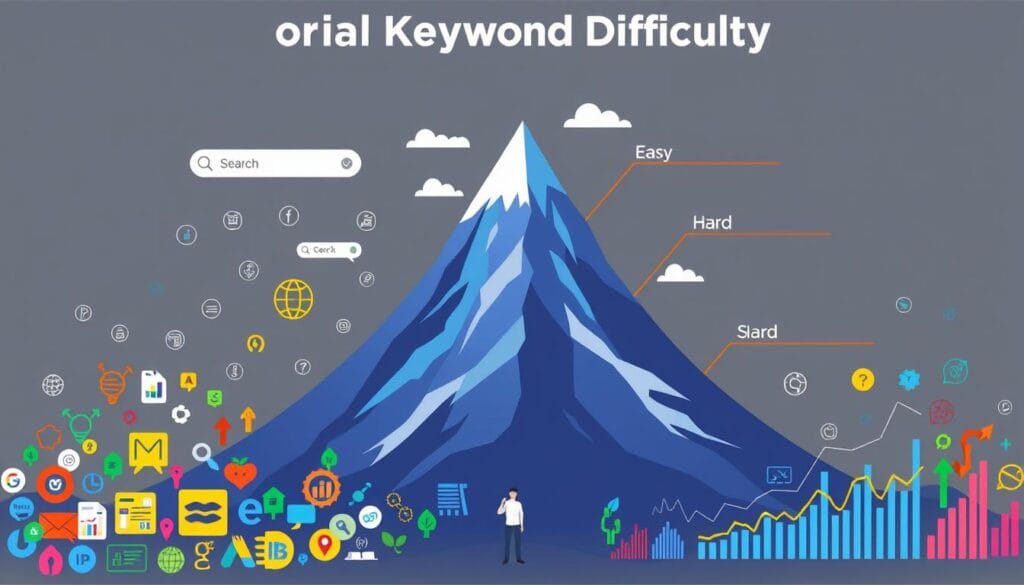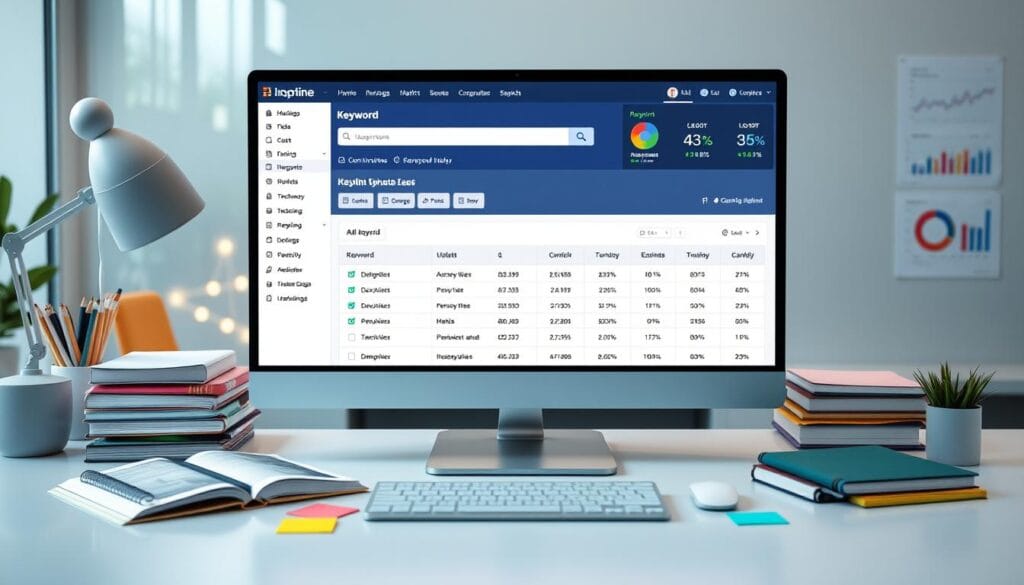Table of Contents
Did you know keyword difficulty scores range from 0 to 100? Keywords like “lose belly fat” have scores up to 83 on Ahrefs and 100% on Semrush. This makes ranking for them very hard12.
Understanding keyword difficulty is key in SEO. It shows how easy or hard it is to rank on the first page of search results2. High-difficulty keywords are harder to rank because of strong competition from other sites with better backlinks and authority1.
Getting organic traffic is getting harder because of lots of competition and “hundreds” of algorithm changes each year2. Knowing keyword difficulty helps choose the right keywords for SEO success.
Introduction to Keyword Difficulty
Understanding keyword difficulty is key for better SEO. It helps SEO experts plan content for the right keywords. This makes our SEO analysis more effective.
What is Keyword Difficulty?
Keyword difficulty shows how hard it is to rank for a keyword. Tools like Ahrefs and Semrush use algorithms to score it. Scores range from 0 to 100, with 100 being the toughest34.
“Car insurance quotes” has a score of 88, making it very competitive5. Knowing this score helps marketers choose the best keywords for their goals.
Importance of Keyword Difficulty in SEO
Keyword difficulty is vital in SEO. It guides how we pick keywords and create content. Sites like Wikipedia face less difficulty34.
For new sites, easier keywords are better for quick wins. We also look at backlinks and domain authority4. This helps us plan better.
How Keyword Difficulty Influences SEO Strategy
Knowing keyword difficulty shapes our SEO plans. Long-tail keywords like “floating floor samples” are easier to rank for5. Tools like Semrush’s Keyword Magic Tool help find these keywords5.
Targeting these keywords can help us reach specific markets faster. We also look at SERP competition and search intent to make content that meets user needs45.
For more on keyword difficulty and SEO, check out the comprehensive guide.
Personal Keyword Difficulty Explained
Personal Keyword Difficulty (PKD) is a special way to measure how hard it is for your website to rank high in search results. It’s different from the general keyword difficulty score because it looks at your website’s unique strengths and authority. This makes it a more personalized approach to picking keywords.

Difference Between General KD and Personal KD
General Keyword Difficulty (KD) scores range from 0 to 100 and show how competitive a keyword is for everyone. But, they don’t consider your website’s special strengths or weaknesses. On the other hand, PKD looks at your site’s authority and specific situation, giving you a score that’s just for you.
For example, MarketMuse’s personalized difficulty score helps you see which keywords are easier for your site to rank for. This makes it clearer which keywords you should aim for based on your content’s strength6.
How to Measure Personal Keyword Difficulty
To measure Personal Keyword Difficulty, you need advanced SEO tools like Semrush and Moz. These tools show you how likely you are to rank high, based on your domain’s strength. If your PKD score is under 20, it means you should either optimize your content or create new pages.
If your score is between 20 and 35, you should improve your existing pages and add more content. Scores between 35 and 50 mean you need to work on your topic clusters. And if your score is over 50, you should start building foundational topic clusters to boost your ranking chances6.
Using Personal KD to Enhance SEO Strategy
Using PKD in your SEO strategy can really help your website do better. By picking keywords that match your site’s strengths, you can find better opportunities for ranking. Tools like Moz’s keyword difficulty checker help you pick the right keywords by looking at how many and what quality of competing pages there are7.
Using PKD scores to focus on niche keywords can also lead to more relevant audience engagement and higher conversion rates7. For example, a small business might find better ranking chances and more meaningful engagement with “custom curtains in Omaha” than with the broader term “curtains”7.
- Identify keywords relevant to your niche with low PKD scores.
- Optimize existing content based on your PKD insights.
- Develop new pages or supporting content for moderately difficult keywords.
- Focus on building foundational topic clusters for high PKD scores.
Understanding and using Personal Keyword Difficulty in your SEO strategy can improve your keyword targeting. It also helps you create content that boosts your site’s rank and authority.
Factors That Affect Keyword Difficulty
Understanding what affects keyword difficulty is key for a good SEO plan. Let’s look at the main things that change this important metric.
Backlinks
Backlinks are a big deal when it comes to keyword difficulty. A page with lots of good backlinks is seen as more trustworthy. This makes it harder for new pages to beat them in rankings. A strong backlink profile can really up the difficulty of ranking for a keyword8.
Search Volume
Search volume is how often people search for a keyword in a month9. Keywords searched more often have more competition, making them harder to rank for8. On the other hand, keywords searched less often might have less competition, giving you a better chance to rank9.
Presence of SERP Features
SERP features like snippets and knowledge panels can really affect keyword difficulty. These features grab more attention, leaving less clicks for other results. They make it harder for websites to get to the top9.
Branded Keywords
Branded keywords are also important. They’re harder to rank for because big brands usually get the top spots. To compete, you need a lot of SEO work and to beat a lot of competition8.
| Factor | Description | Impact on Keyword Difficulty |
|---|---|---|
| Backlinks | Quality and quantity of links pointing to a page | Increases with stronger backlink profiles8 |
| Search Volume | Average monthly searches for a keyword | Higher volume leads to higher difficulty9 |
| SERP Features | Special elements like snippets and knowledge panels | Reduces available organic clicks, increasing difficulty9 |
| Branded Keywords | Keywords including brand names | Higher difficulty due to brand dominance8 |
How to Check Keyword Difficulty
Knowing how to check keyword difficulty is key for a good SEO plan. Tools like Semrush and Ahrefs help with this. They use different methods and metrics.
Using Semrush
Semrush has a Keyword Overview tool that shows keyword difficulty as a percentage. It also gives search volume data at country and global levels. This helps us see how competitive a keyword is10.
It also shows competitive density and historical data. This lets us see how keyword difficulty has changed over time10. Semrush’s 14-day free trial gives us access to a lot of data for keyword research.
Using Ahrefs
Ahrefs uses a Keyword Difficulty metric from over 2 million keywords. It ranges from 0 to 100, with 100 being the hardest11. This metric looks at the number of referring domains needed to rank.
For example, 20 referring domains are needed for a Keyword Difficulty of 20. For a Keyword Difficulty of 90, 756 referring domains are needed11. Ahrefs has a huge database of 19.2 billion keywords. This helps us accurately check keyword difficulty11.

Comparing Different Tools
Semrush and Ahrefs offer different views and features for keyword research. Semrush’s percentage-based score, along with search volume and competitive density, gives a full view of keyword competition10. Ahrefs, on the other hand, has detailed numerical data and a big keyword database.
This makes it great for seeing how backlinks, referring domains, and keyword ranking are connected11.
| Feature | Semrush | Ahrefs |
|---|---|---|
| Keyword Difficulty Metric | Percentage | Numerical Score (0-100) |
| Dataset Size | Not specified | Over 2 million keywords11 |
| Additional Metrics | Search Volume, Competitive Density, CPC, Historical Data10 | Number of Referring Domains, Backlinks11 |
| Keyword Database | Not specified | 19.2 billion keywords11 |
By using insights from these tools, we can make a better SEO plan. This ensures we cover all important metrics and boosts our chances of ranking well.
Interpreting Keyword Difficulty Scores
Understanding keyword scores is key for smart SEO choices.
What Different Scores Indicate
Keyword difficulty scores range from 0 to 100%. A 0% score means it’s easy to rank for12. On the other hand, a 100% score means it’s very hard12. We break these scores into four levels:
- Low Difficulty: 0-29, perfect for new sites
- Medium Difficulty: 30-49, good for sites with solid content and backlinks
- High Difficulty: 50-69, needs strong SEO efforts
- Very High Difficulty: 70+, for top sites
A keyword like “iPhone 15 Pro Max” has a 71% difficulty score and 823,000 searches a month. It’s very competitive12.
How to Use Scores to Make Decisions
Good SEO planning means picking keywords that fit your site’s strength and resources. New sites should aim for keywords under 30 to get quick wins13. Established sites can go for harder keywords with strong backlinks and content14.
For example, “digital marketing strategies for small businesses” is a good target. It has a lower difficulty score but still gets a lot of searches14.
Knowing about keyword scores helps make better SEO choices. By looking at both difficulty and search volume, we find the best keywords. Tools like Semrush’s Keyword Magic Tool help us pick the right keywords for our goals12.
Finding Low-Difficulty Keywords
Looking for low-difficulty keywords is key in SEO. These keywords help us rank faster and with less competition.
Benefits of Targeting Low-Difficulty Keywords
Going after low-difficulty keywords means quicker wins in SEO. They are perfect for new sites to start strong. Keywords with a score of 30 or less are easier to rank for, boosting your chance to show up on Google’s first page15.
By focusing on these, businesses can see more traffic and visibility. This is all without facing tough competition16.
How to Identify Low-Difficulty Opportunities
Spotting low-difficulty keywords is easier than you think. Tools like Semrush’s Organic Research Tool show what keywords competitors rank for15. The Keyword Gap Tool in Semrush also helps by comparing competitors and finding less competitive long-tail keywords15.
Using these tools can reveal niches where ranking is easier. This means more traffic for your site.
Using Keyword Research Tools
Keyword research tools are vital for finding low-difficulty keywords. For example, Semrush’s SEO Content Template analyzes top Google results for a target keyword15. The Keyword Gap Tool filters keywords by search volume and difficulty, helping us find the most valuable ones15.
With tools like Semrush, we can find out what people are interested in. This makes it easier to find keywords that are profitable and less effort15.
Combining Keyword Difficulty with Search Intent
Linking keyword difficulty with search intent helps pick the best keywords. It also makes sure our content meets user needs. This leads to more engagement and better rankings in search results.
Understanding Search Intent
Search intent, or user intent, has three main types: informational, navigational, and transactional. Users looking for answers fall under informational intent, like “best PPC software”. Navigational intent is about finding specific websites, like “Amazon”. Transactional intent is about buying, like “buy PPC software”17.
Knowing these intents helps us create content that really meets user needs.
Aligning Content with Search Intent
It’s key to match our content with search intent for better engagement and sales. For example, for informational intent, we make detailed guides or how-to articles. For transactional intent, we create product pages or buying guides17.
This approach makes sure our content matches what users are looking for.
Using KD and Search Intent Together
Using keyword difficulty (KD) and search intent together helps us choose the best keywords. Low difficulty keywords, below 30, are easier to rank for. They’re great for making targeted content18. Even high difficulty keywords, above 60, can be ranked by authoritative sites if they match the intent well.
Optimizing our content with both KD and intent indicators boosts results. High-quality content that meets specific user needs, paired with a good keyword strategy, leads to better rankings and user satisfaction.

Creating Content to Rank for Keywords
Creating content that ranks well in search engines is key to driving organic traffic. We need to focus on making quality content that meets user needs. Following practical content creation tips is also important.
Importance of Quality Content
High-quality content is crucial for ranking well on search engines. Content over 2,000 words tends to do better. It should aim for a readability score of 60+ (like a 7th to 9th-grade reading level)19.
Also, keeping page load time under 3 seconds can help rank higher19. Such content attracts search engines and keeps users engaged. This leads to better conversions, like a notable increase in signups19.
Addressing User Needs
Meeting user needs through our content is vital for SEO success. By aligning our content with what users search for, we create more relevant material. For example, filtering keywords to ensure a search volume of at least 100 per month confirms a significant audience20.
Using a keyword strategy can boost leads by up to 78% in six months20. This shows how important it is to cater to user requirements. Using informational keywords that answer evergreen questions can also improve our content strategy20.
Practical Tips for Creating Rankable Content
To create content that ranks well, consider these tips:
- Thorough Keyword Research: Find keywords with a balance between competition and search volume. For example, look for a Keyword Difficulty (KD) score of 50% or lower to find easier keywords20.
- Optimize Content Length: Make sure content is over 2,000 words to stand out from competitors. Pages with less than 800 words are often too short19.
- Load Time and Readability: Aim for a page load time of under 3 seconds and a readability score of 60+ to improve user experience and engagement19.
- Engaging Presentation: Use headers, bullet points, and images to enhance readability and keep users interested.
By using these insights and focusing on quality content and user needs, we can create content that ranks well for targeted keywords.
Competitive Analysis for SEO Success
Knowing your competitors is key for good SEO. A deep dive into competitive analysis gives us insights to boost our rankings.
Identifying Competitors
We start by finding the top players in our field. Those who often show up on the first page for the same keywords are our main rivals. They show us who we’re competing with in the SEO game21.
Sites that share many keywords with us are our main organic foes. They usually appear right next to us in search results2122. Keeping an eye on our competitors after Google updates helps us stay on track and adapt22.
Analyzing Competitor Strategies
After finding our competitors, we look into their tactics. We check their content, backlinks, and keywords to see their strong and weak points. By studying their keywords, we can improve our own SEO and attract more visitors23.
Keywords with lots of searches mean more traffic and tougher competition23. Seeing what keywords our competitors are bidding on shows us where we can shine23.
Using Competitive Insights to Improve Rankings
With the insights from our competitors, we can make our SEO better. A keyword gap analysis shows us keywords our competitors rank for but we don’t21. Tools like Ahrefs and Semrush help us sort through competitor data to find good keywords22.
Using these insights, we can make better content, improve our pages, and track our progress23.
In the end, a good competitive analysis gives us the tools and knowledge to keep improving our SEO. This helps us stay ahead in the ever-changing digital world.
Tracking and Measuring Keyword Performance
Tracking and measuring keywords is key to improving SEO. Tools like Ahrefs and Google Analytics help us keep an eye on rankings, traffic, and conversions. These tools give us the data we need to make smart SEO choices.
Tools for Tracking Keyword Performance
Many tools are essential for tracking keywords. Google Search Console, RankWatch, SEMrush, and Ahrefs offer deep insights. For example, Google Search Console lets us see impressions, clicks, and CTR for keywords. Ahrefs helps us track rankings, keyword difficulty, backlinks, and more24.
Interpreting Performance Data
Understanding performance data is crucial. The Click-Through Rate (CTR) shows how engaging our content is. High CTR means our title tags and meta descriptions are working well. Conversions tell us if users are taking the actions we want them to2526.
High impressions and clicks mean our content is relevant. This confirms we’ve chosen the right keywords and optimized well.
Adjusting Strategy Based on Performance
Performance metrics help us adjust our SEO strategy. By tracking search volume, traffic, rankings, and conversions, we get a full picture of how well we’re doing26. Knowing keyword difficulty scores helps us aim for easier keywords to rank better2524.
By monitoring these metrics and making changes based on data, we keep our content fresh. This boosts our SEO performance.
| Tool | Primary Features |
|---|---|
| Google Search Console | Tracks impressions, clicks, and CTR, analyzes search queries |
| Ahrefs | Monitors rankings, keyword difficulty, backlinks, and generates reports |
| SEMrush | Provides in-depth keyword analysis and performance reports |
| RankWatch | Conducts full site audits, identifies high-performing pages |
Common Mistakes in Keyword Difficulty Analysis
When you’re looking at keyword difficulty, it’s key to watch out for common mistakes. These can really mess up your SEO plans.
Overlooking Long-Tail Keywords
One big mistake is ignoring long-tail keywords. They might not get as many searches, but they’re more specific. This makes them easier to rank for. Plus, they often lead to more sales because people are closer to buying.
Using long-tail keywords also helps you not waste time on super tough keywords. For example, “waterproof women’s snow boots” might get you 3% to 5% conversions. But, broad terms like “boots” might only get you 0.5%.
Ignoring Personal KD Scores
Another mistake is not looking at your personal KD scores. These scores take into account your website’s unique stuff, like domain authority. If you ignore them, you might miss out on keywords you can actually get.
Looking at competition with keyword difficulty metrics helps you not waste time on hard keywords. This is really important for small sites. They should aim for keywords that are a bit easier to get.
Focusing Solely on High-Difficulty Keywords
Only going after high-difficulty keywords is a trap. These keywords are super competitive. It’s hard to beat big sites with lots of authority.
This approach can be a waste of time and resources. Mixing in mid and low-volume keywords is better. It helps you match what users are really looking for. For example, “boots” might get a lot of traffic, but “waterproof women’s snow boots” is more likely to lead to a sale.
To wrap it up, avoiding these mistakes helps you make a better SEO plan. Use a mix of long-tail keywords, consider your personal KD scores, and don’t just focus on hard keywords.
- Overlooking Long-Tail Keywords
- Specificity and higher conversion rates
- Prevents overcommitting to high competition
- Ignoring Personal KD Scores
- Missed opportunities for attainable keywords
- Smaller sites benefit from moderate-difficulty keywords
- Focusing Solely on High-Difficulty Keywords
- High competition, lower chances of ranking
- Balance approach with mid and low difficulty keywords
Conclusion
Understanding and using keyword difficulty insights is key to a good SEO plan. By picking the right keywords, we can place our content where it’s most needed. This helps us beat our rivals online. Using both general and personal scores makes our strategy strong and focused.
We’ve learned how things like backlinks and search volume affect keyword difficulty. Tools like Ahrefs and SEMrush use different ways to measure these scores. This shows how complex SEO is27. By using this info, we can improve our ranking on search engines.
To succeed in SEO, we must keep updating our plans as things change. Checking our keyword goals often helps us stay on top. This way, we keep getting more visitors and improve our site’s authority28. By doing this, we make our content better for users and get higher rankings, boosting our site’s traffic29.
FAQ
What is Keyword Difficulty?
Keyword Difficulty (KD) shows how hard it is to rank for a keyword in search engines. It’s key for SEO because it helps find good keywords that aren’t too hard to get but still have some searches.
What is the Importance of Keyword Difficulty in SEO?
Knowing Keyword Difficulty helps guess how easy or hard it is to rank for certain keywords. It guides our SEO plans. It affects how we pick keywords, balancing how competitive they are and how many people search for them.
How Does Keyword Difficulty Influence SEO Strategy?
Keywords with high difficulty are tough to rank for because other sites have more backlinks and authority. By knowing Keyword Difficulty, we can aim for easier but still valuable keywords. This helps us get more visibility and better search rankings.
What Is the Difference Between General KD and Personal KD?
General KD looks at competition in general. Personal Keyword Difficulty (PKD) is about how hard it is for your site to rank, based on its authority. PKD takes into account your site’s unique situation.
How Do We Measure Personal Keyword Difficulty?
Measuring PKD uses tools like Semrush. They show how easy it is to get top spots, considering your site’s strength. This helps us pick better keywords for our SEO.
How Can We Use Personal KD to Enhance SEO Strategy?
By understanding PKD, we can choose keywords that are within our site’s reach. This makes our SEO efforts more focused and effective, aiming for the best results.
How Do Backlinks Affect Keyword Difficulty?
Good backlinks make a keyword harder to rank for because they show authority. Sites with lots of backlinks are harder to beat, making those keywords more competitive.
What Role Does Search Volume Play in Keyword Difficulty?
More people searching for a term means more sites trying to rank for it. This makes the difficulty score go up.
How Do SERP Features Impact Keyword Difficulty?
Features like snippets and knowledge panels make keywords harder to rank for. They grab user attention and clicks, making it tougher to get organic traffic.
Why Are Branded Keywords Usually High in Difficulty?
Branded keywords are hard because brands usually own them. They have a lot of authority and relevance, making it hard for others to rank.
How Can We Check Keyword Difficulty Using Semrush?
Semrush shows keyword difficulty as a percentage. It helps us see how competitive a keyword is and plan our SEO strategy better.
How Can We Check Keyword Difficulty Using Ahrefs?
Ahrefs gives a score out of 100 for keyword difficulty. It shows backlink strength and competition, helping us pick the right keywords.
Why Is It Important to Compare Different Keyword Research Tools?
Comparing tools like Semrush and Ahrefs gives a full view of keyword landscapes. Each tool’s different ways of measuring difficulty help us make better choices.
What Do Different Keyword Difficulty Scores Indicate?
Low scores mean easier ranking chances, good for new sites. High scores mean it’s tough, needing strong SEO and more resources.
How Can We Use Keyword Difficulty Scores to Make Decisions?
We focus on keywords that offer the best value by looking at difficulty scores. This helps match our SEO goals with achievable improvements.
What Are the Benefits of Targeting Low-Difficulty Keywords?
Going for low-difficulty keywords can lead to quick wins. They face less competition, making them great for new sites or those looking to grow in specific areas.
How Can We Identify Low-Difficulty Keyword Opportunities?
Use keyword tools to find keywords with low difficulty scores. This helps spot terms that can drive traffic without too much competition.
Why Should We Use Keyword Research Tools?
Tools help find valuable keywords, analyze competition, and give important metrics like difficulty scores. This ensures our keyword choices are informed and effective.
What Is Search Intent?
Search intent is why users search for something. Knowing if they want info, navigation, or to buy helps us create content that meets their needs.
How Can We Align Content with Search Intent?
Create content that directly answers user queries and needs. Understand and match the intent behind keywords, making sure our content is relevant and valuable.
How Can We Use Keyword Difficulty and Search Intent Together?
Using keyword difficulty and search intent together helps choose the right keywords and create content that resonates. This boosts engagement and improves our ranking chances.
Why Is Quality Content Important for Ranking?
Quality content meets user intent, provides useful info, and solves problems. It’s key for ranking and keeping users engaged.
How Can We Address User Needs in Content Creation?
Understand user queries and needs to create content that answers questions, offers solutions, and provides insights. This improves user satisfaction and keeps them engaged.
What Are Practical Tips for Creating Rankable Content?
Do thorough keyword research, match content to user intent, and present it clearly. Use headers, bullet points, and images to make it easy to read and engaging.
How Do We Identify Competitors for SEO Success?
Find competitors by researching who ranks for your target keywords. Use tools like Semrush or Ahrefs to uncover them and see their strategies.
How Can We Analyze Competitor Strategies?
Look at the keywords they target, the quality of their content, and their backlinks. This helps us understand their strengths and weaknesses.
How Can We Use Competitive Insights to Improve Rankings?
Adopt successful strategies from competitors, avoid their mistakes, and find gaps to exploit. This boosts our SEO efforts and improves rankings.
What Tools Are Useful for Tracking Keyword Performance?
Tools like Ahrefs and Google Analytics track keyword rankings, traffic, and conversions. These insights help us optimize our SEO strategies.
How Should We Interpret Performance Data?
Understand trends, identify successful tactics, and find areas for improvement. This ensures our SEO strategies are informed and effective.
How Can We Adjust Strategy Based on Performance?
Based on performance data, refine your keyword focus, improve content quality, and adjust your SEO efforts. This aligns with what drives traffic and conversions.
Why Is Overlooking Long-Tail Keywords a Mistake?
Long-tail keywords offer niche opportunities with less competition. Ignoring them means missing out on valuable traffic sources.
Why Shouldn’t We Ignore Personal KD Scores?
Ignoring Personal KD scores means missing chances to rank for keywords our site can actually get. Personal KD gives a tailored approach to keyword targeting.
Why Is Focusing Solely on High-Difficulty Keywords a Pitfall?
High-difficulty keywords are super competitive and hard to rank for. Focusing only on them wastes effort and resources without good results.










